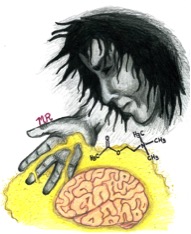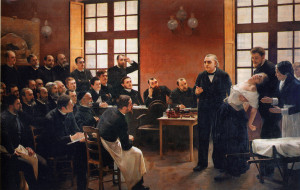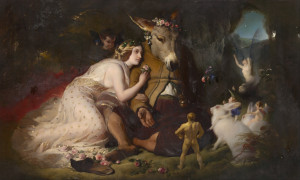
“Dreaming is an act of pure imagination, attesting in all men a creative power, which if it were available in waking, would make every man a Dante or Shakespeare” – Frederic Henry Hedge
The Scientific Chronicles – Dream decoded
 Recently a friend loaned me ‘The Sandman Chronicles’. For the uninitiated, this graphic series authored by Neil Gaiman is a wonderful work in giving a human like interpretation of ‘Dream’. It opens with dream’s capture and imprisonment by a group of men and evolves into a fantastical tale of his past and present adventures. But outside the fictional world, scientists have done a lot of research to ‘capture’ the elusive concept of the dream.
Recently a friend loaned me ‘The Sandman Chronicles’. For the uninitiated, this graphic series authored by Neil Gaiman is a wonderful work in giving a human like interpretation of ‘Dream’. It opens with dream’s capture and imprisonment by a group of men and evolves into a fantastical tale of his past and present adventures. But outside the fictional world, scientists have done a lot of research to ‘capture’ the elusive concept of the dream.
For a long period of time, dreaming has only been explained in psychological terms. In his magnum opus, Sigmund Freud explained dreams as mostly repressed urges (which he expected to be primarily animalistic and sexual in nature) guided by a conflict between the id and the ego explaining the general negative and nightmarish quality of the dream.  His pupil, Carl Jung however, saw dreaming as a way to connect the mind to the subconscious. According to him, dreams were actually SOS signals sent by the mind to help deal with a current stressful situation in the dreamer’s life. This need to interpret the archaic messages in dreams thus led to a lot of interest in ascribing tarot-like meanings to many dream symbols.
His pupil, Carl Jung however, saw dreaming as a way to connect the mind to the subconscious. According to him, dreams were actually SOS signals sent by the mind to help deal with a current stressful situation in the dreamer’s life. This need to interpret the archaic messages in dreams thus led to a lot of interest in ascribing tarot-like meanings to many dream symbols.
Scientific research has now refuted most of these prophetic concepts surrounding dreaming though. One of the greatest breakthroughs in explaining the dream content and nature was the discovery of REM sleep in 1952. Dreaming is mostly associated with the REM sleep cycle that is characterized by selective activation and deactivation of certain brain networks. For example, it has been found that the occipito-temporal cortex and the amygdala are active during REM sleep. The occipito-temporal lobe is associated with the vision cycle and auditory processing whereas the amygdala is the emotional powerhouse of a person, which explains why dreams are a visual, auditory, and highly emotional experience.
Scientists have further explained the bizarre imagery of the dream narrative to be due to the specific deactivation of the dorsolateral prefrontal cortex (DLPFC) in the brain, which is involved in mental functions like cognition and memory. Another mystery about dreaming is the inability to remember the dream upon awakening. A meta-analysis of positron emission tomographic (PET) studies found that reduced activity of frontal and parietal cortexes of the brain is linked to the fragmented recall of dream elements. Jeffrey Sutton has also recently linked an increase in acetylcholine levels in the brain during REM sleep as being responsible for this memory consolidation implicating a neurochemical basis in the dreaming scenario.  According to him there is a hubbub of brain network activity associated with incongruous emotional, visual and perceptual cues occurring during dreaming. Humans try to make sense of it all by combining these cues together to make one complete story which is what makes dreams so bizarre. Sutton believes that the dream narrative is a side effect of the chemical changes occurring during REM sleep as the same change is associated with learning and consolidating memories.
According to him there is a hubbub of brain network activity associated with incongruous emotional, visual and perceptual cues occurring during dreaming. Humans try to make sense of it all by combining these cues together to make one complete story which is what makes dreams so bizarre. Sutton believes that the dream narrative is a side effect of the chemical changes occurring during REM sleep as the same change is associated with learning and consolidating memories.
But not all dreams are delusional. There is one particular type of dream where one seems to be in control of the dream content and is able to recall it vividly upon awakening – the lucid dream. Think of the movie Inception! In fact, there is an entire industry out there manufacturing everything from pills to apps in helping people discipline the art of lucid dreaming.  Be it a delusion or a reality, numerous instances are out there where dreaming has helped inspire new songs, movies, inventions, and scientific discoveries (the structure of DNA came to James Watson in a dream!).
Be it a delusion or a reality, numerous instances are out there where dreaming has helped inspire new songs, movies, inventions, and scientific discoveries (the structure of DNA came to James Watson in a dream!).
So, what’s really the difference between an idea and a dream? Can the state of somnolence associated with the latter be used as a primal distinction from the former? Scientists presently are determined more than ever to take dream research to the next level by defining ‘dream genes’ that govern this process. Insight into the field of dreams will not only help us to understand sleep and brain physiology but will also garner more avenues to treat psychological and sleep disorders. I, for one, can’t wait for a course in oneirology where the ability to doze off in class might actually be an absolute requirement, highly appreciated by the professor!
Peer edited by Laura Taylor
Illustrated by Meagan Ryan
Follow us on social media and never miss an Everyday Questions article:
It is a very well written blog and another exceptional piece of work from someone who is living his dream